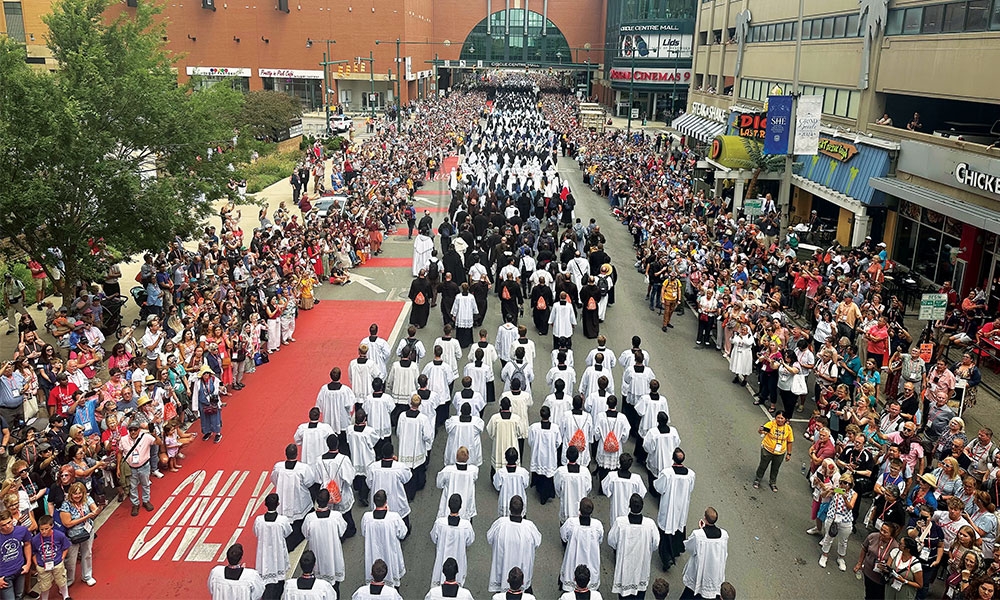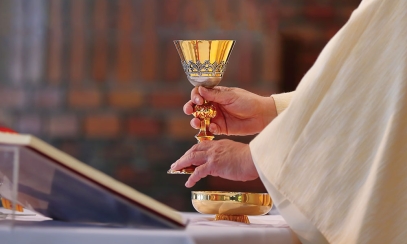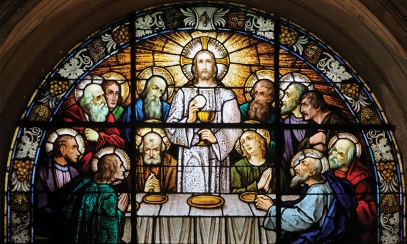
Sacrament of love
In June 2022, the Catholic Church in the United States began a three-year initiative to inspire a renewed encounter with Jesus Christ in the Eucharist. This movement, the National Eucharistic Revival, was crowned by the first National Eucharistic Congress in 83 years. For five days, more than 55,000 participants filled Lucas Oil Stadium in Indianapolis to be formed as witnesses to the Church’s faith in the Real Presence of Christ in the Blessed Sacrament.
Inspired by the mission of the National Eucharistic Revival, this column presents an accessible catechesis on the Eucharist to help readers encounter Jesus in the Blessed Sacrament and become his faithful witnesses in the world.
In June 2022, the Catholic Church in the United States began a three-year initiative to inspire a renewed encounter with Jesus Christ in the Eucharist. This movement, the National Eucharistic Revival, was crowned by the first National Eucharistic Congress in 83 years. For five days, more than 55,000 participants filled Lucas Oil Stadium in Indianapolis to be formed as witnesses to the Church’s faith in the Real Presence of Christ in the Blessed Sacrament.
Inspired by the mission of the National Eucharistic Revival, this column presents an accessible catechesis on the Eucharist to help readers encounter Jesus in the Blessed Sacrament and become his faithful witnesses in the world.
God in our midst: The (remarkable) Catholic claim about the Eucharist
“My delights were to be with the children of men.” (Prv 8:31)
The Prudential Tower, located in Boston’s Back Bay neighborhood, is home to restaurants, upscale clothing retailers, software developers and law firms. But among the thousands of souls who visit the 52-story skyscraper each day, how many are aware that the tower is also home to God?
In a small chapel inconspicuously situated between a coffee shop and an Italian restaurant, a sanctuary lamp burns day and night. If it could speak, the flame would invite passersby to pause and spend a few moments alone with the creator of the universe.
Jesus Christ, the Church has always professed, is present in the consecrated Host housed in the tabernacle.
This is the Catholic claim:
After the priest prays the words of consecration over the bread and wine at Mass, these elements are no longer bread and wine. They are really – not symbolically – changed into the body, blood, soul and divinity of Jesus Christ, who is God.
Transubstantiation
“The other day Céline was saying, ‘How is it that God can be in such a little Communion host?’ Little Thérèse said, ‘That’s not so surprising since God is all-powerful.’ ‘What does that mean, ‘all-powerful’?’ ‘Well, it means he can do what he wants! …” -Letter of St. Zélie Martin, mother of St. Thérèse of Lisieux, to her sister
For many years, the question the Church wrestled with was not if the bread and wine could become the body and blood of Christ – after all, God can do whatever he wants – but how to explain the phenomenon in human language. After all, the change that takes place at Mass is wholly unique and has no equivalent in the natural world.
Finally, theologians settled on a new word to describe this remarkable event: transubstantiation. This word literally denotes a “change of substance.” After the priest pronounces the words of consecration, the bread and wine, despite retaining the appearances of bread and wine, are bread and wine no longer. The “substance,” or “stuff,” of the consecrated elements is the body, blood, soul and divinity of God.
The Eucharist in God’s plan
“And behold, I am with you always, until the end of the age.” (Mt 28:20)
Confronted with this teaching, we can either reject it as absurd (as many of those who abandoned Jesus did after his “Bread of Life” discourse) or we can embrace it as fully consistent with what we know about God and about how he relates to human beings.
Proof of God’s love
We know, for example, of God’s unconditional love for us and his desire to be with us. Indeed, the Incarnation, in which God became man, would be proof enough of his love. We should never cease to wonder that he “emptied himself, taking the form of a servant, being born in the likeness of men.” (Phil 2:7) But 33 years with a relatively small number of people were not enough for God! He desired to remain with us forever, and thus he instituted the sacrament by which, while reigning in heaven, he could be present not only in one place on earth, but in all of the tabernacles of the world.
Perpetual sacrifice
Observing religious practice throughout history, we also see that human beings have an innate inclination to worship God by offering him sacrifice. People in almost every time and place have offered sacrifice. In the Old Testament, the Jewish people made sacrifices to praise, thank and petition God and to ask his forgiveness for sin. Although Jesus’ self-offering on the cross made all other sacrifices obsolete, the impulse to use sacrifice as a form of worship was still essential to the way we relate to God. Thus, God, in his wisdom and goodness, gave us the Eucharist by which we could daily offer Jesus’ perfect sacrifice on the cross until the end of time.
Spiritual food
Finally, we know that God ardently desires our sanctification and provides us with all of the help we need to become holy. This help comes primarily in the form of grace, which God dispenses in great measure when we receive him with devotion in holy Communion. According to the 13th-century Doctor of the Church St. Thomas Aquinas, one reason Christ chose to use bread and wine for the Eucharist was to show us that the sacrament would be spiritual food intended to strengthen our souls with his grace. Just as bodily food is used for bodily nourishment, so the Eucharist is spiritual food intended for spiritual nourishment.
The Real Presence
“When they had eaten their fill, [Jesus] told his disciples, ‘Gather up the fragments left over, that nothing may be lost.’” (Jn 6:12)
Jesus spoke these words after miraculously multiplying five barley loaves and two fish to feed more than 5,000 weary followers. Although this event occurred before he instituted the Eucharist, the Church understands the multiplication of the loaves as pointing to the abundance of spiritual nourishment God would provide in the sacrament. Jesus’ instruction to his disciples, “Gather up the fragments … that nothing may be lost” illuminates an important point in the Church’s Eucharistic teaching: Christ becomes present, whole and entire, in each of the species – the bread and the wine – and he remains fully present in every particle, no matter how small. Thus it becomes the responsibility of his priests to ensure that no fragment of his Eucharistic body, so much more valuable than leftover bread, is lost or desecrated.
For priests and laypeople alike, the Real Presence of Jesus in the Eucharist is an immense gift and a great responsibility. Each of us can deepen our awareness of his presence and inspire the faith of others by the reverence we show to Jesus in the tabernacle.
An Ambassador for Christ: Blessed Carlo Acutis
Blessed Carlo Acutis, whose canonization will take place at the Vatican in April 2025, offers an example of someone whose love for the Eucharist inspired him to become Jesus’ “ambassador.” Born in 1991, the computer-savvy Italian millennial loved to attend daily Mass and told his mother shortly after his first Communion, “To always be united to Jesus: This is my life plan.” He believed that stories of Eucharistic miracles could convince people of the truth of the Real Presence. Consequently, he created a website documenting Eucharistic miracles and approved Marian apparitions which launched shortly before his death from leukemia in 2006. The corresponding Eucharistic miracles exhibition has been displayed in thousands of parishes in the United States alone.


